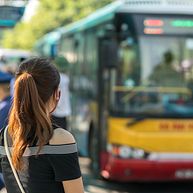
-
![red corded home phone]() Provided by: Miryam León/Unsplash
Provided by: Miryam León/Unsplash

Our travel guides are free to read and explore online. If you want to get your own copy, the full travel guide for this destination is available to you offline* to bring along anywhere or print for your trip.
*this will be downloaded as a PDF.Price
€4,95
Telephone
The guide was updated:Country code: +84
Area code: 4
Useful Information
Digital Travel Guide Download
Our travel guides are free to read and explore online. If you want to get your own copy, the full travel guide for this destination is available to you offline* to bring along anywhere or print for your trip.
*this will be downloaded as a PDF.Price
€4,95

Hanoi’s sparkling new Nội Bài International Airport is the second largest and busiest airport for passenger traffic in Vietnam. It is located 28km away from Hanoi city centre.
Hanoi city bus numbers 7 and 17 leave from the right side of the terminal exit and take an hour to reach the city centre. They run from 5am–10pm, every 15-20 minutes.
Airport minibuses congregate outside the arrival hall–the Vietnam Airlines minibus takes about 40 minutes and drops you outside their Hoan Kiem Lake office (south end). Tickets are sold inside the terminal building. However, many travellers opt for a taxi–there are hundreds outside the terminal exit gate. Unlike the minibuses, which run only intermittently at night, taxis are present 24 hours a day. A taxi ride to the city centre takes about 30-40 minutes. Another option for lower fares is the rideshare company Grab.
Read more

Train
Hanoi train station is conveniently located in the city centre, with Gate A serving mainly guests travelling South to Danang, Hue, Nha Trang, and Ho Chi Minh City. Gate B serves guests travelling up north to Sapa. It takes about 10 minutes by taxi from either gate to Hanoi Old Quarter and Hoan Kiem Lake.
Trains depart punctually with a variety of seat options: hard seat, soft seat, hard berth, and soft berth. Despite many shortcomings, taking the train in Vietnam is a safe and reliable means of transportation and an essential way for travellers to visit places such as Sapa.
Read more

Public Transport
Taking a bus in Hanoi can be a convenient way to navigate the city, though it often demands patience and familiarity with the system. The bus network in Hanoi is extensive, covering most parts of the city, and fares are relatively cheap. That said, the bus routes, schedules, and signage may not always be easy to understand for visitors, as they are primarily in Vietnamese. Yet, major routes often feature English signage, and select buses provide electronic announcements in both Vietnamese and English.
However, Hanoi is generally quite easy to explore on foot. Many of the city's attractions, markets, and neighbourhoods are within walking distance of each other, especially in the Old Quarter and around Hoan Kiem Lake.
Read more

Taxi
In bustling Hanoi, taxis are abundant. Make sure that your ride is charged according to the taxi meter. Having exact change handy is wise since drivers frequently lack it. For smooth communication, write down your destination as pronunciation challenges may arise. Alternatively, opt for Grab, Southeast Asia's Uber equivalent, through which rides can be conveniently arranged via the app.
Read more

Pharmacy
Pharmacy is called 'nhà thuốc' in Vietnamese. They can be found on nearly every square block of the city. Some of the main pharmacy chains in Hanoi, include Pharmacity and FPT Long Châu.
Read more

Telephone
Country code: +84
Area code: 4
Read more

Electricity
In Vietnam, electrical outlets typically operate at 220V/50Hz and commonly use plug types A and C. Type A features two flat parallel pins, while type C has two round pins. Travellers are advised to carry a power plug adapter to ensure compatibility with local sockets when visiting Vietnam.
Read more


